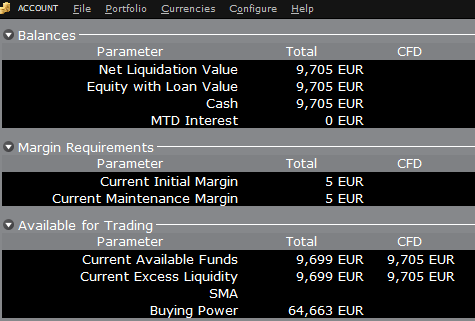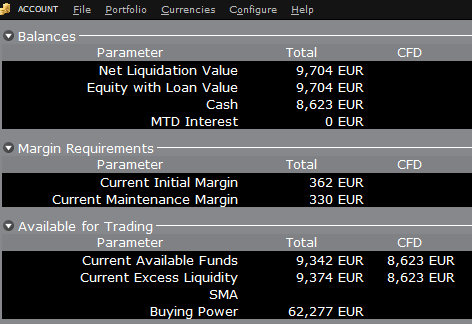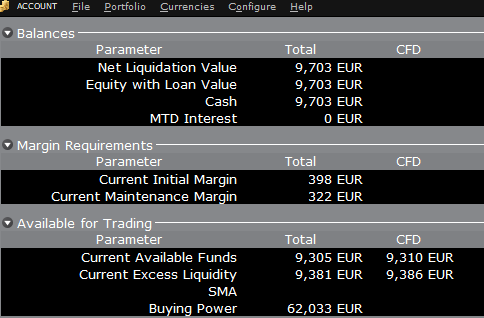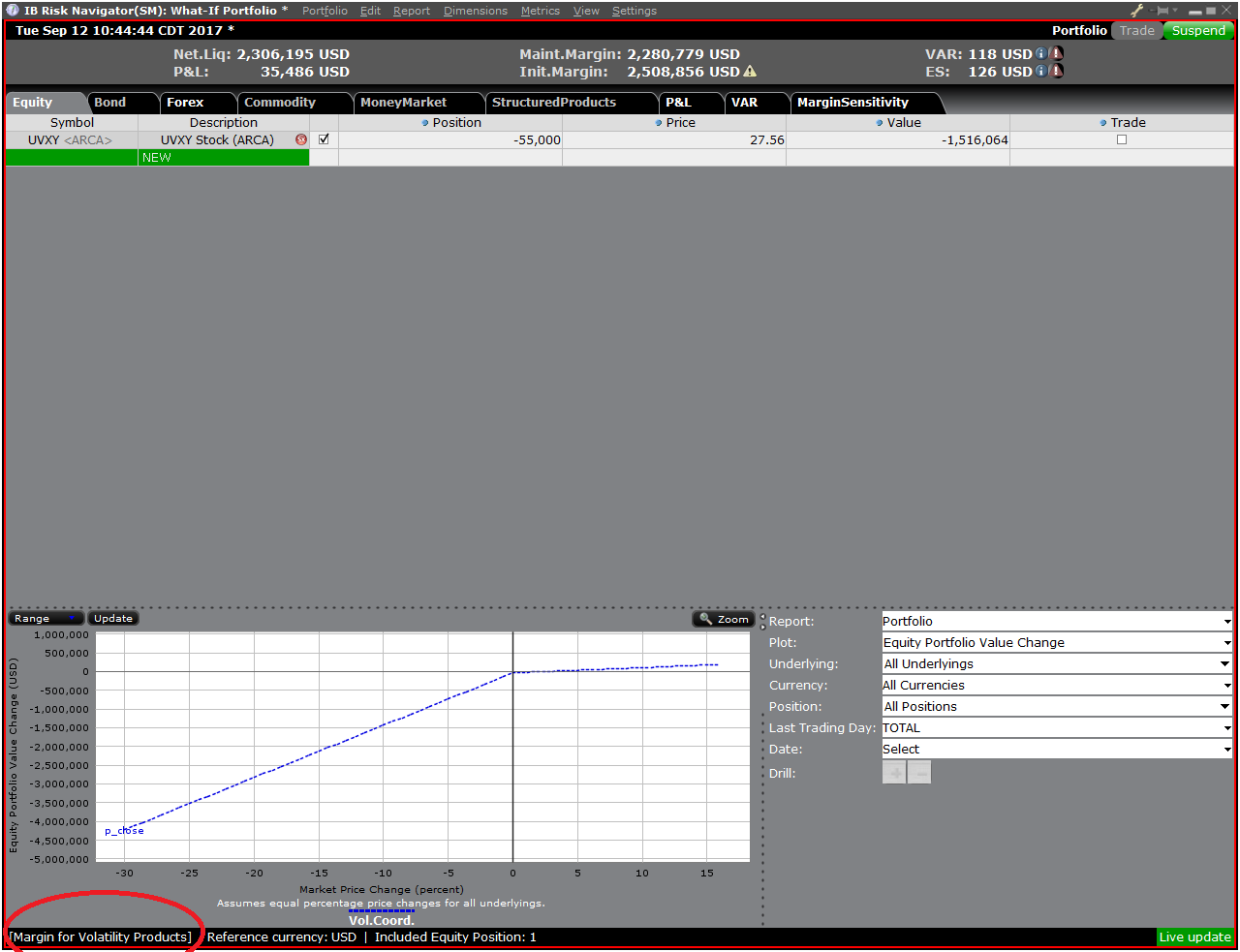Interazione di TWS e MacOS 12 (Monterey)
Questo articolo riguarda la performance di Trader Workstation (TWS) in ambiente MacOS Monterey (versione: 12), in base a quanto segnalato da alcuni clienti. TWS potrebbe bloccarsi o chiudersi inaspettatamente (crash) quando opera con il sistema MacOS 12. Questo potrebbe verificarsi subito durante la fase di avvio di TWS oppure successivamente, alle volte dopo pochi minuti oppure dopo alcune ore.
Implementazione della rettifica
È stata pubblicata una rettifica in TWS Beta, disponibile per essere scaricata qui
Questa procedura ha richiesto una grande quantità di test in modo da consentirci di stabilire quale fosse la piattaforma Java migliore per Trader Workstation e inoltre come evitare di introdurre altri problemi nel tentativo di risolvere quello attuale.
Ti ringraziamo per la pazienza dimostrata.
Tempistica dei dati di mercato in differita
Di solito i fornitori di dati di mercato offrono i dati relativi alle borse in due categorie: dati in tempo reale e dati in differita. I dati di mercato in tempo reale vengono diffusi non appena le informazioni diventano di pubblico dominio. I dati in differita invece hanno un ritardo di circa 10-20 minuti rispetto alle quotazioni in tempo reale.
Alcune borse consentono di mostrare dati in differita senza alcun abbonamento, a titolo gratuito. Più in basso in questo articolo vengono indicate le borse che offrono i dati in differita senza costi e alcuna richiesta formale (es. i dati in differita verranno mostrati non appena verrà inserito il simbolo del prodotto nella piattaforma di trading). La tabella include inoltre i corrispondenti abbonamenti in tempo reale e i costi per potervi accedere dal sito web di IBKR.
Nota Bene:
- In ottemperanza con i requisiti normativi, IBKR non offre più informazioni in differita relative a quotazioni di titoli statunitensi ai clienti di Interactive Brokers LLC.
- Le quotazioni in differita hanno un valore puramente indicativo e non sono necessariamente utili per il trading Gli orari citati potrebbero essere soggetti a ulteriori ritardi senza preavviso.
Continente americano
| Nome della borsa esterna | Nome della borsa presso IB | Periodo di ritardo | Abbonamento in tempo reale |
| CBOT | CBOT | 10 minuti | CBOT in tempo reale |
| CBOE Futures Exchange | CFE | 10 minuti | CFE Enhanced |
| Market Data Express (MDX) | CBOE | 10 minuti | Indici CBOE Market Data Express |
| CME | CME | 10 minuti | CME in tempo reale |
| COMEX | COMEX | 10 minuti | COMEX in tempo reale |
| ICE US | NYBOT | 10 minuti | ICE Futures U.S. (NYBOT) |
| Mexican Derivatives Exchange | MEXDER | 15 minuti | Mexican Derivatives Exchange |
| Mexican Stock Exchange | MEXI | 20 minuti | Mexican Stock Exchange |
| Montreal Exchange | CDE | 15 minuti | Montreal Exchange |
| NYMEX | NYMEX | 10 minuti | NYMEX in tempo reale |
| NYSE GIF | NYSE | 15 minuti | NYSE Global Index Feed |
| One Chicago | ONE | 10 minuti | OneChicago |
| OPRA | OPRA | 15 minuti | OPRA Top of Book (L1) (US Option Exchanges) |
| OTC Markets | PINK | 15 minuti | OTC Markets |
| Toronto Stock Exchange | TSE | 15 minuti | Toronto Stock Exchange |
| Venture Exchange | VENTURE | 15 minuti | TSX Venture Exchange |
Europa
| Nome della borsa esterna | Nome della borsa presso IB | Periodo di ritardo | Abbonamento in tempo reale |
| BATS Europe | BATE/CHIX | 15 minuti | European (BATS/Chi-X) Equities |
| Boerse Stuttgart | SWB | 15 minuti | Stuttgart Boerse incl. Euwax (SWB) |
| Borsa di Madrid | BM | 15 minuti | Borsa di Madrid |
| Borsa Italiana | BVME/IDEM | 15 minuti | Borsa Italiana (BVME stock / SEDEX / IDEM deriv) |
| Budapest Stock Exchange | BUX | 15 minuti | Budapest Stock Exchange |
| Eurex | EUREX | 15 minuti | Eurex Real-Time Information |
| Euronext | AEB/SBF/MATIF/BELFOX | 15 minuti | Euronext Cash |
| Euronext | AEB/SBF/MATIF/BELFOX | 15 minuti | Euronext Data Bundle |
| Frankfurt Stock Exchange and XETRA | FWB/IBIS/XETRA | 15 minuti | Spot Market Germany (Frankfurt/Xetra) |
| ICE Futures Europe (Commodities) | IPE | 10 minuti | ICE Futures E.U. - Commodities (IPE) |
| ICE Futures Europe (Financials) | ICEEU | 10 minuti | ICE Futures E.U. – Financials (LIFFE) |
| LSE | LSE | 15 minuti | LSE UK |
| LSEIOB | LSEIOB | 15 minuti | LSE International |
| MEFF | MEFF | 15 minuti | BME (MEFF) |
| NASDAQ OMX Nordic Derivatives | OMS | 15 minuti | Derivati paesi nordici |
| Prague Stock Exchange | PRA | 15 minuti | Prague Stock Exchange Cash Market |
| SWISS Exchange | EBS/VIRTX | 15 minuti | SIX Swiss Exchange |
| Tel Aviv Stock Exchange | TASE | 15 minuti | Tel Aviv Stock Exchange |
| Turquoise ECN | TRQXCH/TRQXDE/TRQXEN | 15 minuti | Turquoise ECN |
| Warsaw Stock Exchange | WSE | 15 minuti | Warsaw Stock Exchange |
Asia
| Nome della borsa esterna | Nome della borsa presso IB | Periodo di ritardo | Abbonamento in tempo reale |
| Australian Stock Exchange | ASX | 20 minuti | ASX Total |
| Hang Seng Indices | HKFE-IND | 15 minuti | Indici Hang Seng |
| Hong Kong Futures Exchange | HKFE | 15 minuti | Hong Kong Derivatives (Futures & Opzioni) |
| Hong Kong Stock Exchange | SEHK | 15 minuti | Hong Kong Securities Exchange (Titoli, Warrant & Obbligazioni) |
| Korea Stock Exchange | KSE | 20 minuti | Korea Stock Exchange |
| National Stock Exchange of India | NSE | 15 minuti | National Stock Exchange of India, Capital Market Segment |
| Osaka Securities Exchange | OSE.JPN | 20 minuti | Osaka Exchange |
| SGX Derivatives | SGX | 10 minuti | Singapore Exchange (SGX) - Derivati |
| Shanghai Stock Exchange | SEHKNTL | 15 minuti | Shanghai Stock Exchange |
| Shanghai Stock Exchange STAR Market | SEHKSTAR | 15 minuti | Shanghai Stock Exchange |
| Shenzhen Stock Exchange | SEHKSZSE | 15 minuti | Shenzhen Stock Exchange |
| Singapore Stock Exchange | SGX | 10 minuti | Singapore Exchange (SGX) - Titoli |
| Sydney Futures Exchange | SNFE | 10 minuti | ASX24 Commodities e Futures |
| Tokyo Stock Exchange | TSEJ | 20 minuti | Tokyo Stock Exchange |
Informativa riguardante le notifiche sui massimali di prezzo di Interactive Brokers
Gli enti regolatori del mercato si aspettano che le società di brokeraggio abbiano dei metodi di controllo progettati per impedire che la società possa inviare presso i mercati degli ordini che possano creare il rischio un trading destabilizzante (es. rischio di temporanei ed improvvisi cambiamenti di prezzo).
Per rispettare le normative in questo ambito, Interactive Brokers mette in atto una serie di filtri dei prezzi sugli ordini dei propri clienti. In alcune circostanze questi filtri sui prezzi possono costituire un massimale agli ordini dei clienti allo scopo di evitare effetti destabilizzanti sul mercato. Questi massimali di prezzo saranno in generale in un range percentuale all’interno di un range di prezzi di riferimento calcolato da IB. (Il range dei massimali di prezzo potrà variare in base al tipo di strumento e al prezzo corrente).
Anche se i massimali di prezzo sono uno strumento per bilanciare gli obbiettivi di trading e il rischio di prezzi minimizzati, un’operazione potrà essere ritardata o potrebbe non essere eseguita come effetto del massimale sui prezzi. Maggiori informazioni sono disponibili nella Informativa di Interactive Brokers sul Sistema di indirizzamento degli ordini e Flusso di pagamento degli ordini.
Se agli ordini di un cliente vengono applicati i sistemi di massimale di prezzo di IB, il cliente potrà ricevere: (i) notifiche in tempo reale sui massimali di prezzo in Trader Workstation oppure attraverso l’API o tramite FIX tag 58 (per gli utenti di FIX); (ii) un messaggio di notifica che conterrà un elenco riassuntivo dei primi 10 ordini sui quali è stato applicato il massimale di prezzo nel giorno precedente, il prezzo iniziale del massimale per quegli ordini (ove applicabile) e il range del massimale di prezzo per ulteriori massimali applicati agli ordini in questione.
I clienti potranno decidere di non ricevere altri messaggi di notifica cliccando sul link contenuto nel messaggio contrassegnato come “Notifica per Te”. Inoltre, decidendo di eliminare la ricezione di questi messaggi in futuro, un cliente compirà le seguenti azioni:
- esprimerà il suo assenso circa la rinuncia a ricevere ulteriori notifiche da Interactive Brokers per quanto riguarda l’applicazione dei massimali di prezzo della società che sono stati applicati agli ordini del cliente; e
- prenderà atto di aver compreso che i suoi ordini potranno essere sottoposti ad un massimale di prezzo in futuro ma, al tempo stesso, il cliente dichiara di non voler più ricevere notifiche circa l’applicazione dei massimali di prezzo sui suoi ordini.
Interaction between TWS and MacOS 12 (Monterey)
The present article addresses performance on the Trader Workstation (TWS) under MacOS Monterey (version: 12), as experienced by several clients. The TWS may experience freezes or may shut down unexpectedly (crash) when running on MacOS 12. This can happen immediately during the TWS start up phase or may occur at a later time point, after some minutes or even hours.
Fix Implementation
A fix has been released in the TWS Beta, available for download here
This process included an extensive amount of testing, in order to see which of the alternative Java platforms was the best fit for the Trader Workstation and as well to avoid introducing new issues while solving the current one.
We sincerely thank you for your patience.
TWS Account Window for Retail Clients of IBKR Ireland and Central Europe
This article describes the information provided in the TWS account window for IBKRs EU based entities.
|
CFDs are complex instruments and come with a high risk of losing money rapidly due to leverage. 61% of retail investor accounts lose money when trading CFDs with IBKR. You should consider whether you understand how CFDs work and whether you can afford to take the high risk of losing your money. |
Retail clients who are residents of the EEA and therefore maintain an account with one of IBKR’s European brokers, IBIE or IBCE, are subject to EU regulations which introduce leverage and other restrictions applicable to CFD transactions.
Notably the regulations require the use of free cash to satisfy CFD margin requirements and prohibit retail clients from using securities in the account as collateral to borrow funds to initiate or maintain a CFD position. Please see Overview of ESMA CFD Rules Implementation for Retail Clients at IBIE and IBCE for full details.
The accounts of IBKRs EU entities are universal accounts in which clients can trade all asset classes available on IBKRs platform, but unlike IBKRs US and UK entities, there are no separately funded segments.
Working examples of how this restriction is applied, along with details as to how clients can monitor free cash available for CFD transactions, are outlined below.
Account Window
IBKR enforces the restriction relating to free cash by calculating the funds available for CFD trading on a real-time basis, rejecting new orders and liquidating existing positions when the available free cash is insufficient to cover CFD initial and maintenance margin requirements.
IBKR offers clients the ability to monitor free cash available for CFD transactions via an enhancement to the TWS Account Window which displays the level of free cash in the account. Importantly, the funds shown as available for CFD trading do not imply that cash is held in a separate segment. It simply indicates what proportion of total account balances is available for CFD trading.
For example, assume that an account has EUR 9,705 in cash and no positions. All the cash is available to open CFD positions, or positions in any other asset class:

If the account now purchases 10 shares of AAPL stock for an aggregate value of USD 1,383 the cash in the account is reduced by a corresponding amount in EUR, and the funds available for CFD trading are reduced by the
same amount:

Note that Total available funds are reduced by a smaller amount, corresponding to the stock margin requirement.
If, instead of buying AAPL stock, the account buys 10 AAPL CFDs the impact will be different. As the transaction involves a derivative contract rather than the purchase of the underlying asset itself, there’s no reduction in cash but the funds available for CFDs are reduced by the CFD margin requirement to secure performance on the contract:

In this case Total available funds and CFD available funds are reduced by an equal amount; the CFD margin requirement.
Funding
As noted above, EU-based accounts do not have segments and therefore there is no need for internal transfers. Funds are available for trades in all asset classes in the amounts indicated in the account window, without the need for sweeps or transfers.
Note also that should an account have a margin loan, i.e. negative cash, it will not be possible to open CFD positions since the CFD margin requirement must be satisfied by free, positive cash. Should you have a margin loan and wish to trade CFDs you must first either close margin positions to eliminate the loan, or add cash to the account in an amount that covers the margin loan and creates a cash buffer sufficient for the necessary CFD margin.
Restrizioni relative al portafoglio
Residenti in Lussemburgo (LU): IB Luxembourg (“IB-LUX”) non supporta le Commodity sui metalli (Certificati su London Gold).
Residenti in Europa centrale e Europa dell’Est (Ungheria, Repubblica Ceca, Polonia, Bulgaria, Romania, Croazia, Slovacchia, Estonia, Lettonia, Lituania, Cipro, Malta): IB Central Europe (“IB-CE”) non supporta commodity sui metalli. Inoltre IBCE al momento supporta solo le seguenti valute: EUR, USD, CZK, HUF, PLN. A breve saranno disponibili anche GBP e CHF.
Nel caso in cui tu detenga una di queste valute nel tuo portafoglio, dovrai chiudere le relative posizioni appena possibile in modo da poter facilitare il trasferimento del tuo conto. Ti ricordiamo che le posizioni short cash (prestito) non devono essere chiuse immediatamente. Vanno invece chiuse subito le posizioni long.
Portfolio Restrictions
Residents of Luxembourg (LU): IB Luxembourg (“IB-LUX”) cannot support Commodity-Metals (London Gold Certificates).
Residents of Central-Eastern Europe (HU, CZ, PO, BG, RO, HR, SK, EE, LV, LT, CY, MT): IB Central Europe (“IB-CE”) cannot support commodity metals. Furthermore, IBCE currently only supports for the following currencies: EUR, USD, CZK, HUF, PLN. GBP and CHF are expected in the near future.
If you hold any of these currencies in your portfolio, you must close the positions as soon as possible in order to facilitate transfer of your account. Short cash positions (borrowing) do not have to be close immediately, just long positions.
Risk Navigator: Calcolatore del Margine Alternativo
Periodicamente IB rivaluta i livelli di margine e introdurrà dei cambiamenti allo scopo di aumentare i requisiti di margine al di sopra dei minimi a seconda di quanto venga richiesto dalle condizioni di mercato. Per assistere i nostri clienti nel comprendere gli effetti di questi cambiamenti sul loro portafoglio abbiamo aggiunto una nuova funzione detta “Calcolo del margine alternativo” nella applicazione Risk Navigator. Qui di seguito vengono illustrati i passi per creare un portafoglio ipotetico (“what-if”) allo scopo di determinare l’impatto di questi cambiamenti relativi al margine.
Passo 1: Aprire un nuovo portafoglio “What-if”
Dalla piattaforma di trading TWS in modalità Classic, selezionare gli Strumenti di Analisi, Risk Navigator, e poi il menu opzioni Apri Nuovo What-If (Figura1).
Figura 1
.png)
Dalla piattaforma di trading TWS in modalità Mosaic Nuova Finestra, Risk Navigator, e poi il menu opzioni Apri Nuovo What-If menu options.
Passo 2: Definire un portafoglio iniziale
Comparirà una finestra pop-up (Figura 2) nella quale si viene invitati a scegliere se si preferisce creare un portafoglio ipotetico a partire dal portafoglio attuale oppure un creare un nuovo portafoglio. Cliccando sul pulsante “sì” verrà attivato il download delle posizioni esistenti all’interno del nuovo portafoglio “What-If”.
Figura 2

Cliccando sul pulsante “No” si aprirà un portafoglio “What – If” che non contiene posizioni.
Riquadro di Rischio
Il Riquadro di Rischio si trova sopra le schede dei prodotti ed è disponibile per sia per portafogli what-if che per quelli attivi. I valori calcolati vengono su richiesta per i portafogli what-if. Il riquadro fornisce ad un primo sguardo informazioni sul conto che includono:
1) Valore di Liquidazione Netto: il totale del Valore di Liquidazione netto del conto
2) P&L: Il totale giornale di P&L dell’intero portafoglio
3) Margine di Mantenimento: totale del margine di mantenimento attuale
4) Margine Iniziale: totale dei requisiti di margine attuali
5) VAR: Mostra il Valore a rischio dell’intero portafoglio
6) Expected Shortfall (ES): Disavanzo atteso (media del valore a rischio) – questo valore rappresenta il rendimento previsto relativo al portafoglio nel peggiore scenario possibile.

Calcolatore del Margine Alternativo
Il Calcolatore del Margine Alternativo, al quale si accede dal menu delle Impostazioni e cliccando su Margin Mode (Figura 3), mostra come il cambiamento di margine influenzerà il requisito di margine generale.
Figura 3

Passo 3: Selezionare le impostazioni del Margin Mode
Una finestra pop-up comparirà (Figura 4) contenente l’indicazione Impostazioni Margine Mode. Una finestra pop-up comparirà (Figura 4) contenente l’indicazione Impostazioni Margine Mode. Dal menu a scorrimento di questa finestra sarà possibile cambiare i calcoli del margine da Default (ossia l’impostazione corrente) al nuovo titolo della nuova Impostazione di Margine (ossia la nuova impostazione). Una volta effettuata questa selezione, basterà cliccare sul pulsante OK della finestra pop-up.
Figura 4

Dopo aver specificato la nuova modalità di margine, il Riquadro del Risk Navigator verrà aggiornato automaticamente per riflettere la scelta dell’utente. È possibile scorrere avanti e indietro fra le varie impostazioni del Margin Mode. Le ricordiamo che l’attuale Margin Mode verrà mostrato nell’angolo in basso a sinistra della finestra del Risk Navigator (Figura 5).
Figura 5

Passo 4: Aggiungere Posizioni
Per aggiungere una posizione al portafoglio "What - If", basta cliccare sulla fila verde dal titolo “Nuovo” e quindi inserire il simbolo del sottostante (Figura 6), definire il tipo di prodotto (Figura 7) e inserire la quantità di posizioni (Figura 8)
Figura 6

Figura 7

Figura 8

Sarà possibile modificare le posizioni per verificare in che modo cambia il margine. Dopo aver modificato le posizioni, sarà necessario cliccare sull’icona (![]() ) per effettuare un ricalcolo e aggiornare le cifre di margine. L’icona si trova a destra delle cifre di margine. Ogni volta che questa icona è presente significa che tali cifre di margine non sono aggiornate con il contenuto del portafoglio What-If .
) per effettuare un ricalcolo e aggiornare le cifre di margine. L’icona si trova a destra delle cifre di margine. Ogni volta che questa icona è presente significa che tali cifre di margine non sono aggiornate con il contenuto del portafoglio What-If .
Disclosure Regarding Interactive Brokers Price Cap Notices
Regulators expect brokerage firms to maintain controls designed to prevent the firm from submitting orders to market centers that create a risk of disruptive trading (e.g., the risk of sudden, transient price moves).
To comply with these expectations, Interactive Brokers implements various price filters on customer orders. Those price filters may, in certain circumstances, price cap customer orders in order to avoid market disruption, and those Price Caps will generally be in a % range from a reference price range calculated by IB. (The range of the Price Cap varies depending on the type of instrument and the current price.)
Although the price caps are intended to balance the objectives of trade certainty and minimized price risk, a trade may be delayed or may not take place as a result of price capping. More information is available in Interactive Broker’s Order Routing and Payment for Order Flow Disclosure.
If a customer’s order(s) are price capped by IB’s systems, that customer will either receive (i) real-time notification of those price cap(s) in Trader Workstation or via the API or FIX tag 58 (for FIX users); and/or (ii) a daily FYI message containing a digest of the first 10 order(s) that were price capped the prior day, the initial price cap(s) for those order(s) (if applicable), and the Price Cap Range(s) for further Price Cap(s) of those order(s).
Customers may opt out from receiving future FYI Messages by clicking the relevant opt-out link within an FYI Message. By opting out from receiving these future FYI Messages, a customer:
- Agrees to waive any further notifications from Interactive Brokers about the application of the firm’s Price Caps to that customer’s order(s); and
- Acknowledges that he or she understands that his or her orders may be price-capped in the future, but that the customer does not wish to be notified again about the application of any Price Caps to any of his or her orders.
